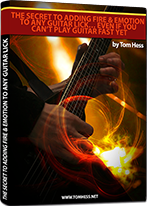How To Play Guitar With Feeling: Secrets To Emotional Guitar Soloing
Emotion To Any Guitar Lick

EMAIL TO GET ACCESS
By submitting your info, you agree to send it to Tom Hess Music Corporation who will process and use it according to their privacy policy.
In this lead guitar article, you’ll discover the secrets to playing emotional guitar solos that let you play guitar with feeling and impress just about anyone who hears you play.
(Most importantly – yourself.)
Big statement, eh?
Most guitarists think that to play guitar with feeling, you need to know a lot of guitar licks, tons of music theory and have advanced guitar technique.
Fortunately – as you are about to see – you don’t need to be a virtuoso musician to play guitar with emotion.
Emotion To Any Guitar Lick

EMAIL TO GET ACCESS
By submitting your info, you agree to send it to Tom Hess Music Corporation who will process and use it according to their privacy policy.
You just need to focus on a few basics of guitar phrasing that:
1. most lead guitarists completely ignore
2. you can easily make a lot of progress with once you know what to do, understand how to do it and actually do it.
I’ll show you all of that.
Ready to start?
To begin, watch this video to understand what it means to play guitar with emotion:
Here are a few more advanced lead guitar tips for how to play guitar with feeling:
Emotional Guitar Soloing Tip #1: Guitar Phrasing Refinement
You know that joke about making a guitar player stop playing by “giving him sheet music”?
Well, I got a better one that also acts as the starting point of your ability to play guitar with feeling
How do you make a lead guitarist stop playing?
Ask him to play just 2 notes... and make ‘em sound pro.
That is exactly what I once asked my students to do. (Many years ago, I held a competition, where I asked students to submit a recording of their 2 notes ... where the best would get a nice prize.)
Only instead of recordings, I got...
Questions. Lots... and lots... of questions.
Like:
“What key?”
“What counts as a ‘lead guitar note’?”
“Is a lead guitar string bend ‘2’ notes or one?”
“When you do vibrato with lots of pulses, that’s typically a whole series of lead guitar notes, no?”
“And slides – that’s also 2 notes, so... I'm just playing 1 lead guitar note with a quick ornament, yes?”
(Of course, I got a ton of KILLER entries from many students too. )
But this made me double down on helping my students shore up possibly the most ignored lead guitar skill of all...
Lead guitar phrasing.
Here is how you can do this in your own playing (and sharpen your ability to play emotional guitar solos), do this:
Play a short lead guitar phrasing idea (it can be any short guitar lick, ideally 2-4 notes long).
Then, pause and imagine that you paid $1000 for the privilege of playing each of those notes. Do you feel like you got your money’s worth based on the lead guitar phrasing you’re hearing?
If you’re not “$1000 happy” with the guitar phrasing sound of each of your lead guitar notes, ask yourself why.
Play the (same) guitar lick again and make each note really count by using better guitar phrasing. If you are doing this over a backing track, you may stay on the same guitar lick for the entire duration of the track.
That’s fine.
As far as guitar phrasing, concentrate on using these lead guitar techniques (that allow you to play guitar with emotion):
- Vibrato (in its main variations: instant, delayed and delayed with re-articulation). This vibrato article goes over the 3 lead guitar vibrato variations in detail.
- Slides. Believe it or not, there are different types of lead guitar slides. There are ascending slides (from a lower pitch to a higher pitch)... descending slides (from a lower pitch, down to a higher pitch), super slides (where you slide up or down by more than 1 octave and backslides (where you play a note, immediately slide up (or down) from it and return back to the original note).
Here is what backslides look and sound like:
- Double stops – and I don’t mean ‘unison bends’, where you play 2 notes on 2 adjacent strings- bending one of them until it’s in tune with the other one.(this is what many lead guitarists use as double stops). What I mean by “double stops” is any combination of guitar licks where you play 2 notes at the same time.
Like this, for example:
- String bends – when it comes to string bends, focus on emphasizing the release of the bend (the most dramatic part of the bend), as well as using ghost bends as part of your lead guitar phrasing. This is where you bend a string up without picking it (in silence), then pick it and release the string back down.
Watch this video to see how cool your guitar licks will sound when you play string bends this way:
Use these 4 lead guitar techniques to refine your guitar licks and watch as playing emotional guitar solos begins to feel easier than ever before.
Emotional Guitar Soloing Tip #2: Model Your Lead Guitar Phrasing (And Lead Guitar Licks) After Great Singers
This may be the single fastest way to learn to play emotional guitar solos and play guitar with emotion.
Why?
Because singers don’t sing the typical lead guitar licks guitarists play. Nor do they use the lead guitar phrasing ornaments guitarists typically use. Nonetheless, the average singer sings melodies (what we’d call “lead guitar licks”) with far more emotion than your average lead guitar player.
This means...
If you transcribe the melodies (and the phrasing) your favorite singers use, you’ll be able to play guitar with emotion at a level few lead guitarists can.

Question: “Tom Hess, what singers should I listen to for this exercise? And how do I practice applying the singer’s melody to help me play emotional guitar solos?”
Answer: Listen to any singers who sing actual pitches and melodies (instead of growling) whom you like listening to. You cannot “choose wrongly” here.
My personal favorite singer (who – without realizing it - has played a big role on my ability to play guitar with feeling and develop emotional lead guitar phrasing) is Fabio Lione.
Next, concentrate on just learning any vocal melody by that singer (using your guitar). Your goal should be to match what you are hearing, including phrasing. Fortunately, since singers can’t typically sing as fast as you can play lead guitar, the only challenges you are likely to face during this step will be relating to ‘guitar phrasing’ – not technique.
Then, use the melody as a skeleton to fill with faster, lead guitar friendly ideas that allow you to play guitar with feeling.
Here is one example of how this might look:
Emotional Guitar Soloing Tip #3: Use Rhythmic Variety In Your Lead Guitar Licks
Believe it or not, rhythm is just as much a part of your ability to play guitar with feeling (and create emotional guitar solos) as the notes you play and the guitar phrasing you use in your guitar licks.
And here are 5 simple ways to practice putting more rhythmic variety into your lead guitar playing:
1. Choose any guitar lick you already know (such as one from a guitar solo you’ve already written)...
... and play it over and over – varying ‘only’ the rhythm of the notes.
Don’t worry (for now) about the guitar phrasing ornaments within the guitar lick. And don’t change the notes of the guitar lick, either.
Only vary the rhythm to come up with new ways to play the guitar lick.
2. Analyze any past guitar solo you’ve written and transcribe (some of) the licks you used in it. This will tell you what rhythmic motives you use most often.
(If you’ve never transcribed rhythm before, it’s a great way to train your musical ear.)
Then, deliberately restrict yourself from playing with those rhythms while practicing your lead guitar playing. (Not because those rhythms are bad, but because it challenges you to create new rhythm ideas for your lead guitar licks that you aren’t in the habit of playing.)
3. Transcribe the rhythms of solos you like (focus on slower/moderately-fast licks within the solo at first) to find rhythm ideas to use in your solos that you aren’t yet using.
This is a very quick and simple way to improve your ability to play guitar with feeling.
4. When you improvise, challenge yourself to not start licks on every downbeat.
(To do this, either sometimes use rests during the downbeat or play licks that go over the bar).
Here is an example of playing lead guitar licks using over-the-bar guitar phrasing:
5. Create a new rhythm idea (by clapping your hands or tapping your hand on a desk) that you wouldn’t normally think of while playing lead guitar licks (or rhythm guitar riffs).
Then write out the note values for your new idea.
Next, practice improvising lead guitar licks (and guitar phrasing ideas) using just that rhythm.
Note: You wouldn’t use this rhythm idea in every guitar solo of course. But since you are doing it for the purpose of ‘practicing’, it’s totally ok to just use one rhythm.
Emotional Guitar Soloing Tip #4: Use Modulating Pitch Function To Help You Play Guitar Feeling
Modulating pitch function is my term for holding out the same lead guitar note over two (or more) chords in a song or backing track. And it enables you to play guitar with feeling in very powerful ways.
For example:
 Become A Much Better Songwriter
Become A Much Better SongwriterLearn new and innovative ideas to
quickly improve your songwriting.
 Improve Guitar Playing Creativity
Improve Guitar Playing CreativityLearn the main reasons why you
struggle to be creative on guitar.
 How To Create Killer Guitar Licks
How To Create Killer Guitar LicksGet tons of new ideas to improve your lead guitar playing creativity.
Let’s say you want to play an emotional guitar solo over the chords D major 7 – F# minor - B minor add 9 and A7.
These chords all have 1 note in common: note C#.
D major 7 has notes D F# A C#.
F# minor has notes F# A C#.
B minor add 9 has notes B D F# C#.
A7 chord has notes A C# E G.
If you hold a lead guitar note (in one of your guitar licks) out over all 4 chords, it would sound and feel different over each one.
That’s because C# is the 7th of the D major 7 chord, the 5th of the F# minor chord, the 9th of the B minor add 9 chord and the 3rd of the A7 chord.
And each of these functions sounds nothing like the others. Which creates an awesome opportunity for you to play guitar with feeling and easily create emotional guitar solos.
Best of all?
Modulating pitch function sounds great no matter what guitar lick you play, even if you don’t have great guitar phrasing chops yet.
Watch this video to see and hear this lead guitar concept in action:
Emotional Guitar Soloing Tip #5: Use Advanced String Bending Variations
We talked about using standard lead guitar string bends earlier in this article. But there is quite a bit more to string bends than just regular lead guitar bends or ghost bends.
Check out this video with advanced lead guitar string bending variations and use them to add more emotion to your guitar licks:
Now that you know the basics of what it means to play guitar with emotion, I want to show you how to take any of your guitar licks and inject more feeling into them without playing anything fast or difficult. I show you how in my free eGuide: The Secret To Adding Fire & Emotion To Any Guitar Lick ... Even If You Can’t Play Guitar Fast Yet. Download it today and discover the secrets of emotional guitar soloing you need to play guitar like a pro.

Transform your guitar playing with the best rock guitar instruction online.


